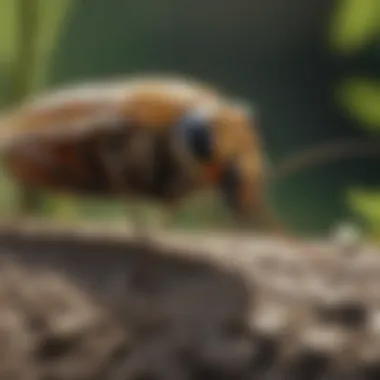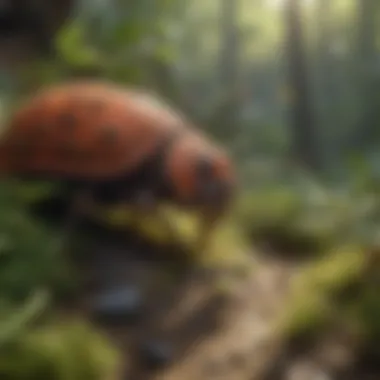Innovative Approaches to Envirotech Pest Management


Intro
Understanding pest management is essential for maintaining healthy living environments. The integration of environmental technology, often termed envirotech, represents a pivot in how we address pest issues. This guide explores innovative solutions that not only target pests but also ensure the sustainability of our ecosystems.
The relevance of this topic is increasingly apparent. As urbanization and climate change escalate, pest populations grow, often leading to significant challenges for homeowners and those responsible for property maintenance. By combining modern technology with sustainable practices, we can create preventive measures and control methods that preserve ecological integrity.
Understanding the Pest
Identification
Identifying a pest is the cornerstone of effective management. Each pest species has distinct characteristics. Knowledge of these traits assists in developing targeted strategies. Common household pests include ants, cockroaches, termites, and rodents. Homeowners should consider engaging in regular inspections to keep track of any infestation.
Life Cycle
Understanding the life cycle of pests is crucial. Many common pests have multiple life stages: egg, larva, pupa, and adult. For instance, termites start as eggs, then larvae, before reaching maturity. This knowledge helps in timing control measures effectively. Interrupting the life cycle can significantly reduce pest populations over time.
Pest Prevention Strategies
Prevention is always better than cure. Here are two vital strategies to consider.
Environment Modification
Making changes to the environment can deter pests. Here are some steps:
- Remove standing water and fix leaks to eliminate moisture.
- Seal cracks and gaps in walls, doors, and windows.
- Maintain cleanliness in and around the home to reduce food sources.
Physical Barriers
Physical barriers are simple yet effective deterrents. Installing screens on windows and doors can prevent insects from entering. Using traps also helps to catch pests without chemicals. These methods minimize reliance on harmful substances, aligning with eco-friendly practices.
Control Methods
When pests are already present, control methods need to be implemented.
Chemical Control
Chemical control involves the use of pesticides. While effective, this method requires careful consideration of the potential impact on non-target species and the environment. Selecting environmentally friendly products, such as organic pesticides, can mitigate adverse effects.
Biological Control
Biological control utilizes natural predators to manage pest populations. For example, introducing ladybugs can help control aphid populations in gardens. This method aligns with sustainable practices by promoting the use of natural processes to maintain pest levels.
"Effective pest management balances the need for control with environmental responsibility."
Preamble to Envirotech Pest Management
Pest management plays a crucial role in maintaining the ecological balance within our surroundings. It encompasses a variety of methods to control pest populations that threaten human health, agriculture, and property. "Envirotech" petrains to environmental technology, which focuses on innovative approaches to manage pests while prioritizing ecological integrity and sustainability.
The integration of these two fields leads to environmentally conscious practices that not only minimize harm but also promote long-term solutions. This article aims to shed light on the significance of combining envirotech with pest management, emphasizing the benefits and necessary considerations for successful implementation.
Defining Envirotech
Envirotech refers to the use of technology aimed at improving environmental sustainability. In the context of pest management, this could include various tools, software, and techniques designed to identify, control, and monitor pest populations while minimizing ecological impact. Some common examples are remote sensing technology, precision agriculture tools, and bioinformatics software. These innovations allow for more effective pest detection, timely intervention, and better resource management. By relying on accurate data and advanced technologies, practitioners can reduce the reliance on harmful chemical pesticides and enhance the overall efficiency of pest control efforts.
Importance of Pest Management
Effective pest management is essential for several reasons. Firstly, it helps protect human health by reducing exposure to disease-carrying organisms such as rodents and mosquitoes. Secondly, pest control safeguards agricultural productivity. Crop infestations can result in substantial economic losses, and without effective management, food security can be jeopardized.
Moreover, a well-designed pest management strategy reduces the potential for property damage, which can save homeowners significant amounts of money in repairs.


The Role of Technology in Pest Control
The advent of technology has transformed various fields, and pest control is no exception. Technology plays a critical role in modern pest management. This section will explore the significance of technological advancements in controlling pests effectively while considering environmental impacts. The integration of innovative tools and data analysis has made pest control more efficient. This benefits not only the pest management industry but also homeowners looking for sustainable solutions to pest problems.
Innovative Tools and Techniques
Innovative tools for pest control have emerged, making it simpler to manage infestations intelligently. These tools range from physical devices to software applications. For example, smart traps equipped with sensors can detect pests and alert homeowners immediately. This real-time data allows for prompt responses, minimizing damage and reducing the need for extensive chemical treatments.
Additionally, automated spraying systems can target specific areas with pinpoint accuracy, thus reducing the volume of pesticides used. Innovations like drones are also revolutionizing how pest management is performed. They can survey large areas quickly, identifying pest hotspots and optimizing treatment plans effectively.
Utilizing these modern techniques ensures that pest management is more efficient and environmentally friendly. It signifies a paradigm shift from broad-spectrum applications to precision pest control, ultimately reducing chemical exposure for humans and pets.
Data-Driven Pest Management
Data-driven pest management is an approach revolutionizing the industry. The collection and analysis of data regarding pest populations, environmental conditions, and treatment effectiveness enhance decision-making. Pest management professionals can leverage historical data and predictive modeling to forecast pest behavior and optimize treatment schedules.
For instance, the use of Geographic Information Systems (GIS) can help identify areas at higher risk of pest infestations. This allows for tailored interventions that are both timely and effective. Additionally, machine learning algorithms can analyze trends over time, helping to anticipate potential pest surges before they occur.
By adopting a data-driven approach, pest management becomes proactive rather than reactive. This not only saves costs but also promotes sustainable practices by reducing excessive treatments. The marriage of technology and data in pest management is shaping a future where pest control is more strategic, tailored, and respectful of environmental considerations.
"Technology in pest management moves from a reactive to a proactive stance, addressing problems before they escalate."
Environmental Impacts of Pest Control
The methods used in pest control have far-reaching consequences that go beyond the immediate area of application. Understanding these impacts is crucial for ensuring the health of ecosystems. When pest management strategies are implemented without consideration for environmental factors, they can lead to detrimental effects on non-target species, soil, and water health. In this section, we will dive into how pest control practices can alter ecological balances and the importance of adopting sustainable methods that minimize these impacts.
Effects on Non-Target Species
Pest control is often aimed at specific pests, but chemicals and methods can unintentionally affect other species. Non-target species, which include beneficial organisms such as pollinators and predators, can suffer. For example, using broad-spectrum insecticides may eliminate pests but also harms essential beneficial insects like bees and natural pest predators like ladybugs. The reduction in these species can lead to an increase in pest populations, creating a cycle that is hard to break.
Furthermore, the loss of biodiversity can disrupt the food chain and lead to unforeseen ecological consequences. For instance, when insecticides kill off butterflies, birds that rely on them for food may decline. This situation highlights the need for targeted pest control strategies that protect these non-target species and maintain ecological balance.
Soil and Water Health
Soil and water health are integral to sustainable pest management. Chemical runoff from pest control practices poses a significant threat. Pesticides can leach into groundwater or enter surface waters, affecting aquatic life and potentially contaminating drinking water. This situation poses health risks not only to wildlife but also to humans relying on the same water sources.
In addition to chemical runoff, soil health can be compromised by the use of certain pesticides. The application of heavy chemicals can disrupt the natural microbial communities within the soil. Healthy soil requires a diverse array of organisms for nutrient cycling, which in turn, supports plant health and agricultural productivity. When soil integrity is compromised, it can lead to reduced crop yields and a reliance on even more chemicals for plant growth.
Sustainable pest control practices must prioritize the health of both the soil and water to ensure long-term viability of ecosystems.
Integrating Ecosystem Management
Integrating ecosystem management is a vital concept in the realm of Envirotech Pest Management. This approach emphasizes the importance of viewing pest control through a wider lens, recognizing that ecosystems and pest populations are interconnected. By adopting a holistic perspective, homeowners and pest management professionals can find effective solutions that respect both human needs and environmental integrity.
Ecosystem management focuses on maintaining the health of an ecosystem while balancing pest control needs. It encompasses a range of strategies that enhance biodiversity, restore natural habitats, and promote the coexistence of various species. By prioritizing these elements, pest control practices can become more sustainable and less reliant on harmful chemical interventions.
Understanding Pest Ecology
Understanding pest ecology is essential for effective ecosystem management. Pest ecology studies the relationships between pests, their natural enemies, and the environment. Knowing these connections helps identify when pests become a problem and what factors contribute to their population growth. Different pests have unique life cycles, behaviors, and ecological roles, which means solutions must be tailored specifically to each situation.
When homeowners understand pest ecology, they can make informed choices about pest management strategies. For example, certain pests thrive in disturbed environments. Recognizing this can guide efforts to restore habitat and remove conditions that favor pest populations. By doing this, we can work towards a more balanced ecosystem.
The Role of Beneficial Insects
Beneficial insects play a crucial role in ecosystem management. These insects contribute to pest control naturally, providing an alternative to synthetic pesticides. For instance, ladybugs and lacewings are known for their appetite for aphids. Without the need for chemicals, these insects maintain pest populations at manageable levels.
Incorporating beneficial insects into pest management strategies can lead to the following benefits:
- Natural pest control: They help regulate pest numbers naturally, reducing the need for chemical applications.
- Biodiversity promotion: Engaging with beneficial insects encourages a diverse and healthy ecosystem.
- Soil health: Many beneficial insects assist in soil aeration and organic material breakdown, enhancing overall fertility.


To attract beneficial insects, homeowners can create a conducive environment through methods such as planting native flowers, avoiding broad-spectrum pesticides, and maintaining diverse plant life. This not only benefits pest management but also enriches the overall ecological landscape around homes.
"Integration of ecosystem management principles into pest control offers a sustainable pathway that aligns human needs with ecological integrity."
Sustainable Pest Control Methods
Sustainable pest control methods are essential in the modern approach to Envirotech pest management. These methods prioritize ecological balance and aim to mitigate the harm to the environment that can be caused by conventional pest control practices. They emphasize using a combination of strategies that are effective yet considerate of non-target organisms, which is particularly crucial for maintaining biodiversity.
The relevance of sustainable pest control stems from the necessity to manage pest populations without relying solely on chemical pesticides, which can contribute to environmental degradation. As society grows more aware of ecological issues, these sustainable methods provide a framework for responsible pest management that aligns with current environmental goals.
Cultural Control Strategies
Cultural control strategies focus on changing farming or management practices to reduce pest populations. For instance, adjusting planting times and crop rotation can disrupt pest life cycles. This method considers environmental factors and integrates them into pest management, exploiting the vulnerabilities of pests rather than just applying chemicals.
Some effective cultural practices include:
- Crop rotation: Alternating crops to disrupt pest habitats.
- Companion planting: Using plants that naturally repel pests.
- Maintaining proper sanitation: Keeping the area free of debris to minimize hiding places for pests.
These strategies not only help to reduce reliance on chemical solutions but also encourage healthy soil and plant growth. Employing cultural control methods can lead to a more resilient agricultural system while managing pest populations effectively.
Biological Control Measures
Biological control measures leverage natural predators or parasites to manage pest populations. Instead of relying on synthetic chemicals, this method uses living organisms, which can offer a sustainable solution to pest issues. Introducing beneficial insects like ladybugs or parasitic wasps can effectively reduce pest populations without harming the ecosystem.
The benefits of biological control include:
- Long-term pest management: Biological agents often establish themselves, maintaining control over time.
- Eco-friendliness: Natural methods reduce chemical input and potential harm to non-target species.
- Minimal resistance development: Pests are less likely to develop resistance to biological factors compared to synthetic pesticides.
In summary, sustainable pest control methods highlight the shift towards a more considerate approach in pest management. Cultural strategies and biological controls not only mitigate existing pest problems but also promote a healthier environment for future generations. Understanding these methods is key for homeowners and housewives aiming to maintain their spaces while being sensitive to ecological integrity.
Chemical Pest Control: A Necessary Evil?
In the realm of pest management, chemical control often surfaces as a contentious topic. Its importance cannot be overstated, especially when considering the effectiveness of treatments against pervasive pests. Moreover, chemical pest control remains vital for ensuring health and safety in residential spaces. This section discusses the various types of chemical methods available and the inherent risks and benefits that house owners must navigate.
Types of Chemical Control
Chemical pest control encompasses several approaches, each serving specific needs. Here are the prominent categories:
- Insecticides: Designed specifically for insects, these chemicals target various life stages, from larvae to adults. Common examples include pyrethroids and neonicotinoids.
- Herbicides: These are used primarily in outdoor settings to control unwanted vegetation. Glyphosate is a widely recognized herbicide for its broad-spectrum action.
- Fungicides: Aimed at managing fungal infestations, fungicides protect plants from mildew and rot, crucial for maintaining healthy gardens.
- Rodenticides: These chemicals are explicit in their purpose—dealing with rodent populations. Anticoagulants like bromadiolone are commonly used in this category.
Different chemical types address specific pest challenges. Each has its unique application method, dosage, and timing.
Risks and Benefits
When considering chemical pest control, a careful assessment of risks and benefits is prudent.
Benefits:
- Effectiveness: Chemicals can rapidly reduce pest populations, giving immediate relief in severe infestations. This is particularly important for health-sensitive zones like kitchens.
- Targeting Specific Pests: Many modern chemicals can be tailored to target specific pests with minimal impact on non-target species. This allows for a more controlled management approach.
- Integration with other methods: Chemical controls can work synergistically with biological and cultural methods, enhancing overall pest management effectiveness.
Risks:
- Environmental Impact: Chemical substances can affect non-target organisms, leading to biodiversity loss. This concern requires consideration of the broader ecosystem.
- Health Concerns: Pesticides pose risks to humans and pets if misused, leading to health dilemmas. Proper education on application is paramount.
- Resistance Development: Over-reliance on chemical solutions can lead to pesticide resistance in pest populations, making management more challenging over time.
"Chemical pest control must be approached with caution and a comprehensive understanding of its broader implications."
Regulations in Pest Management
Regulations in pest management play a critical role in ensuring effective and environmentally responsible practices. As the awareness around ecological impacts grows, regulatory frameworks have emerged to balance harmful pest control with safeguarding ecosystems. It is vital that both the consumers and pest management professionals understand these regulations. They ensure safe usage of pesticides, promote public health and protect biodiversity.


Establishing regulations can prevent over-reliance on pesticides which may cause resistance developments in pests. This resistance not only increases costs but also complicates pest management efforts and endangers non-target species. Furthermore, regulations guide the sustainable use of chemical treatments, ensuring compliance with national and international standards.
Effective pest management regulations benefit society by minimizing health risks related to exposure to pesticides. Regular updates to these regulations based on the latest research findings help keep the practices relevant and effective. In addition, adhering to these regulations fosters consumer trust in pest management businesses by demonstrating a commitment to safe and ethical practices.
"Regulatory frameworks act as a shield for both ecosystems and public health, guiding pest management towards sustainable solutions."
Understanding Current Regulations
Current regulations are often influenced by both local and federal guidelines. In the United States, the Environmental Protection Agency (EPA) oversees the registration and usage of pesticides. This body evaluates the safety and efficacy of chemical controls before approving them for public use. Local state authorities often modify these regulations to reflect regional ecological concerns.
Regulatory compliance also involves strict labeling standards and usage instructions. Labels inform users about application sites, rates, and precautions necessary for safe use. It is crucial for consumers and pest managers to thoroughly understand these guidelines to ensure legality and safety in pest control practices.
Additionally, alternative pest management methods like organic treatments often have their own set of regulations. These methods might be more favorable for some consumers, but they still require adherence to specific guidelines to avoid infringements.
Compliance in Pest Control Practices
Compliance in pest control practices encompasses a range of actions that pest management professionals must undertake to align with established regulations. This includes training for applicators, ensuring they are knowledgeable about the chemicals they handle, their potential risks, and appropriate application techniques. Proper training is essential for maintaining compliance and ensuring safety for both the user and the environment.
Routine inspections and documentation are also crucial aspects of compliance. Companies must keep detailed records of pest management activities, including the type of pest, chosen control methods, and quantities of chemicals used. These records can be vital for audits and show adherence to regulations.
In addition to procedural compliance, staying informed about legislative changes is necessary. Regulatory frameworks can evolve based on new scientific data or environmental considerations. Pest management professionals must keep up to date with these changes to maintain compliance and provide safe pest management solutions.
The Future of Envirotech Pest Management
In recent years, the landscape of pest management has evolved, aligning closely with advancements in environmental technology. This evolution is crucial in creating efficient and responsible solutions that meet both pest control needs and ecological preservation. The future of envirotech pest management is focused on blending innovation with sustainable practices, addressing current challenges while considering the long-term health of our environment.
As we explore the future, it becomes essential to recognize the multiple dimensions involved. This includes technological integration, consumer expectations, and regulatory frameworks. The benefits of adopting new strategies are significant. They promote healthier living spaces, evolved profit opportunities for pest control businesses, and minimize impacts on non-target species.
Emerging Technologies
Emerging technologies are pivotal in shaping the future of envirotech pest management. These innovations enhance pest detection and treatment processes, making them more effective and environmentally sound. Technologies like artificial intelligence (AI) and machine learning offer possibilities for predictive analysis in pest populations. They help anticipate outbreaks more accurately, thus optimizing response strategies.
Key Innovations Include:
- Smart Traps: These devices can automatically detect pests and send alerts to property owners. They reduce the need for frequent inspections, thus saving time and labor.
- Drone Surveillance: Drones allow for extensive monitoring of large areas, offering real-time data on pest infestation levels. This insight is invaluable for making data-driven decisions.
- Biological Sensors: These sensors identify pest presence and evaluate their impact on ecosystems. Understanding this impact guides more focused control measures.
These technologies not only improve efficiency but also empower users to make informed choices in pest management. Adopting such innovations will likely create a paradigm shift in how pest management is understood and executed.
Trends in Eco-Friendly Practices
The shift toward eco-friendly practices in pest management is no longer a niche trend; it has become a major focal point. Consumers are increasingly demanding solutions that do not compromise their health or the environment. This demand is shaping the direction pest control companies are taking.
Significant Trends to Note:
- Increased Use of Biopesticides: Derived from natural materials, these substances lessen the harm to beneficial organisms and minimize chemical residues.
- Integrated Pest Management (IPM): This approach emphasizes a holistic method by combining mechanical, cultural, biological, and chemical tools. The goal is to create sustainable pest control protocols that prioritize ecological integrity.
- Consumer Education: There is a growing emphasis on educating homeowners about pest management options. More informed customers make choices aligned with sustainable practices.
The future of pest management hinges not only on technological advancement but also on societal acceptance of eco-friendly methods.
The End
In this exploration of envirotech pest management, we discover its critical role in addressing pest problems while maintaining ecological balance. This method utilizes technology to provide effective pest control solutions that do not compromise environmental health. The conclusion encapsulates key takeaways, reinforcing the need for an integrated approach.
Summary of Key Points
- Technological Innovation: Advances such as precision agriculture and drones revolutionize pest management. They help in identifying pest outbreaks promptly and targeting treatments accurately.
- Environmental Considerations: An emphasis on non-toxic methods and the reduction of harmful chemical use is vital for protecting ecosystems.
- Sustainability Goals: Implementing sustainable practices ensures long-term pest control that aligns with environmental goals, promoting the health of soils and water.
- Regulatory Compliance: Following existing regulations is essential to ensure safe pest management practices while adhering to environmental standards.
- Future Trends: Emerging technologies continue to shape eco-friendly pest control, promoting methods that are both effective and safe for humans and wildlife.
Call for Sustainable Practices
The conversation around pest management must steer toward a more sustainable future. It is imperative for householders and property owners to consider environmentally friendly methods.
"The intersection of technology and nature can redefine our approach to pest control, but only if we commit to sustainable practices."
Adopting eco-conscious pest management strategies includes:
- Utilizing beneficial insects to tackle pest problems organically.
- Applying cultural practices, like crop rotation, to disrupt pest life cycles.
- Investing in advanced tools that minimize pesticide reliance.
By embracing these sustainable methods, we contribute positively to our environment while achieving effective pest control.







